Bank Regulatory Framework and Earning Power
VerifiedAdded on 2023/01/19
|10
|2568
|41
AI Summary
This report analyzes the impact of regulatory environment on the profitability of banks and the strategies they adopt to manage risk. It also examines the Basel III regulations and their implications on lending and earning power of banks.
Contribute Materials
Your contribution can guide someone’s learning journey. Share your
documents today.
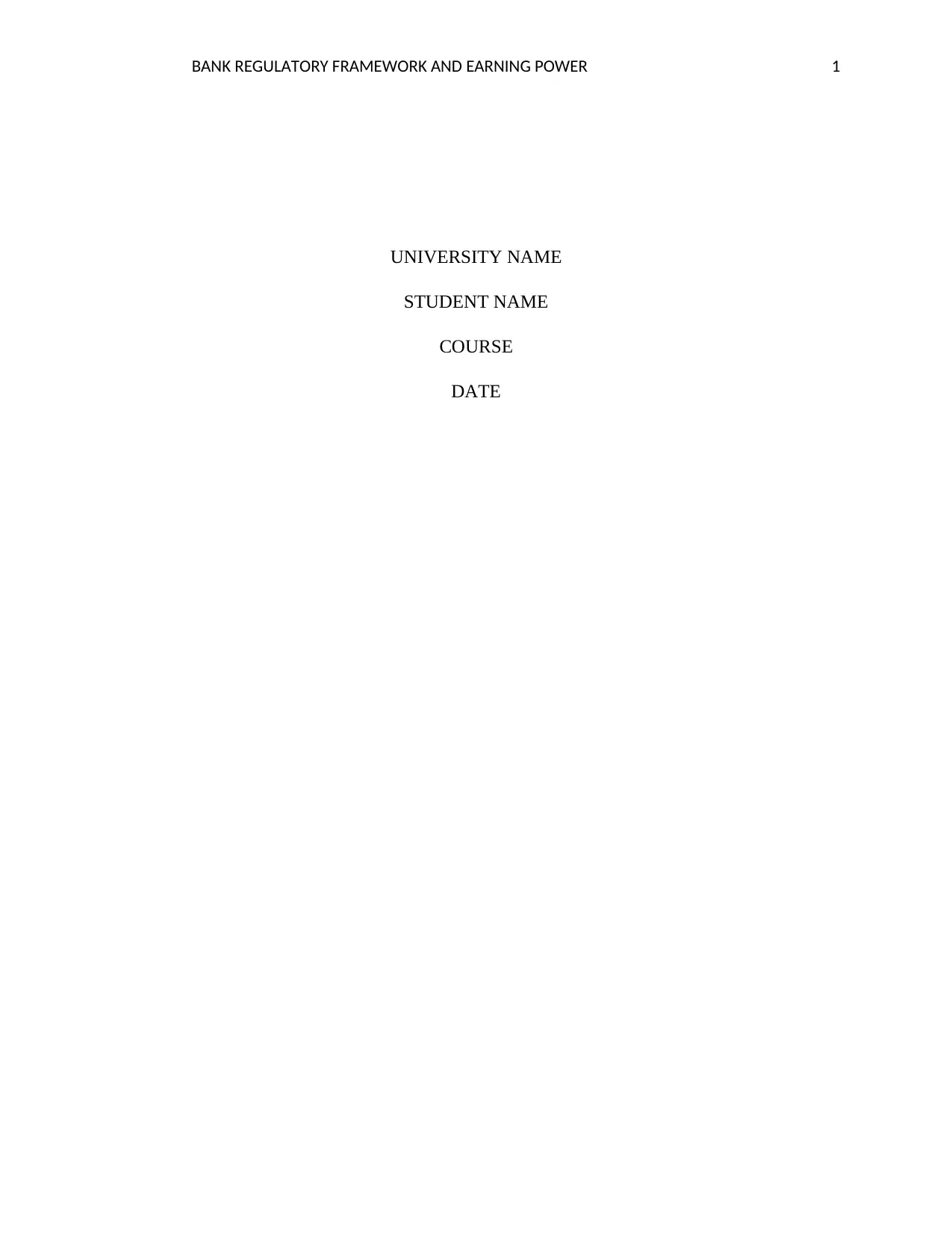
BANK REGULATORY FRAMEWORK AND EARNING POWER 1
UNIVERSITY NAME
STUDENT NAME
COURSE
DATE
UNIVERSITY NAME
STUDENT NAME
COURSE
DATE
Secure Best Marks with AI Grader
Need help grading? Try our AI Grader for instant feedback on your assignments.

BANK REGULATORY FRAMEWORK AND EARNING POWER 2
EXECUTIVE SUMMARY
The purpose of this report is to analyze whether regulatory environment that various financial
institutions such as banks act as hindrance to the profitability of these banks since they
emphasize so much on lending to only a few customers who are perceived to be less risky.it also
aims at examining the fact that raising capital to the required level by banks can help them
manage risk associated to lending. When banks raise meets their capital requirements, they then
concentrate much on improving the quality of their loans.
According to BASEL III regulations, banks should guard themselves from strategic risk. The
purpose of this report therefore is to define that risk and proposes a way to estimate economic
capital requirements.
Financial institutions like banks provide key support to the entire economy. For sound and stable
economic growth, there must be a stability in the banking system of a country. Just like any other
business that operates in an economy, banks are much more exposed to a lot of risks.
EXECUTIVE SUMMARY
The purpose of this report is to analyze whether regulatory environment that various financial
institutions such as banks act as hindrance to the profitability of these banks since they
emphasize so much on lending to only a few customers who are perceived to be less risky.it also
aims at examining the fact that raising capital to the required level by banks can help them
manage risk associated to lending. When banks raise meets their capital requirements, they then
concentrate much on improving the quality of their loans.
According to BASEL III regulations, banks should guard themselves from strategic risk. The
purpose of this report therefore is to define that risk and proposes a way to estimate economic
capital requirements.
Financial institutions like banks provide key support to the entire economy. For sound and stable
economic growth, there must be a stability in the banking system of a country. Just like any other
business that operates in an economy, banks are much more exposed to a lot of risks.
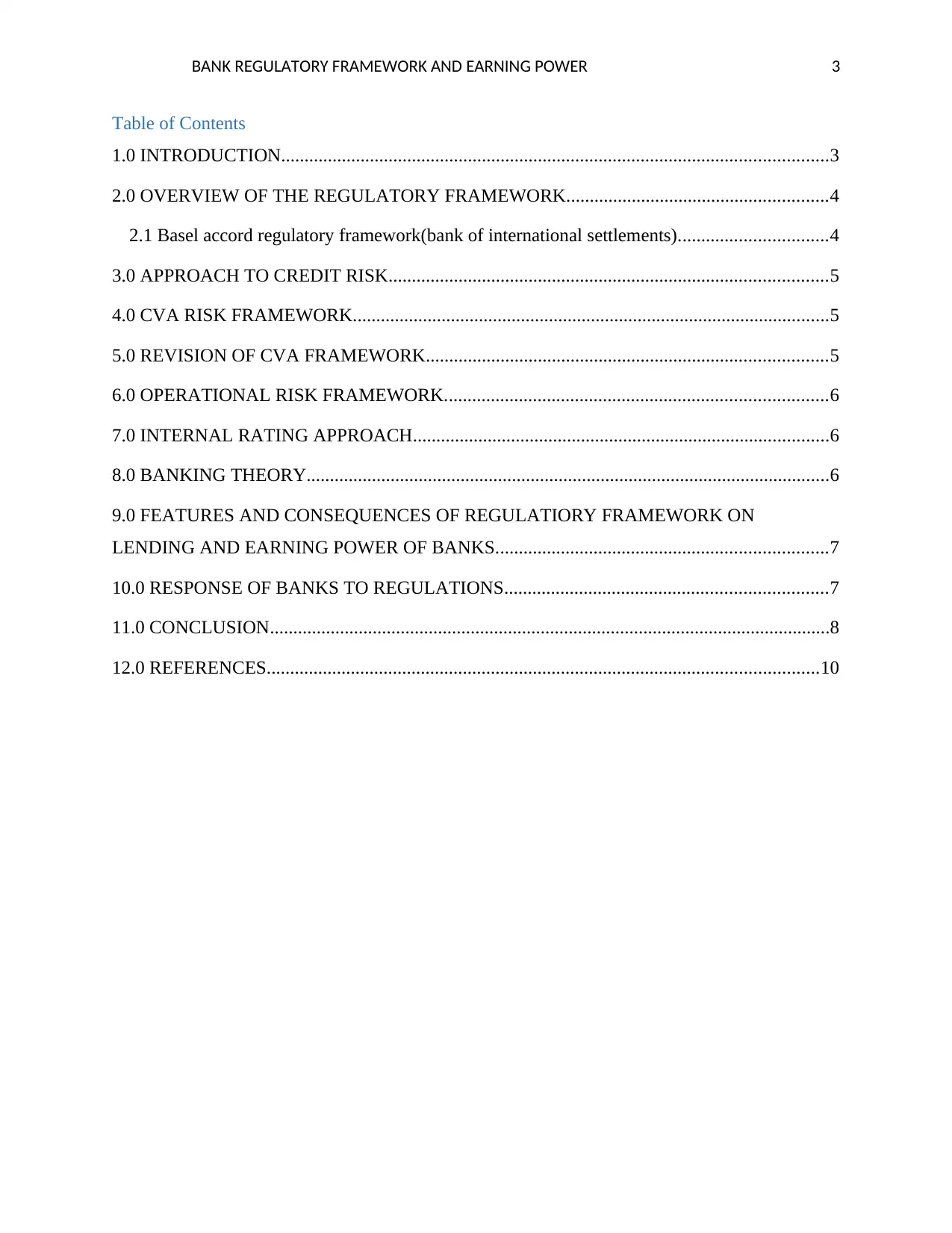
BANK REGULATORY FRAMEWORK AND EARNING POWER 3
Table of Contents
1.0 INTRODUCTION.....................................................................................................................3
2.0 OVERVIEW OF THE REGULATORY FRAMEWORK........................................................4
2.1 Basel accord regulatory framework(bank of international settlements)................................4
3.0 APPROACH TO CREDIT RISK..............................................................................................5
4.0 CVA RISK FRAMEWORK......................................................................................................5
5.0 REVISION OF CVA FRAMEWORK......................................................................................5
6.0 OPERATIONAL RISK FRAMEWORK..................................................................................6
7.0 INTERNAL RATING APPROACH.........................................................................................6
8.0 BANKING THEORY................................................................................................................6
9.0 FEATURES AND CONSEQUENCES OF REGULATIORY FRAMEWORK ON
LENDING AND EARNING POWER OF BANKS.......................................................................7
10.0 RESPONSE OF BANKS TO REGULATIONS.....................................................................7
11.0 CONCLUSION........................................................................................................................8
12.0 REFERENCES......................................................................................................................10
Table of Contents
1.0 INTRODUCTION.....................................................................................................................3
2.0 OVERVIEW OF THE REGULATORY FRAMEWORK........................................................4
2.1 Basel accord regulatory framework(bank of international settlements)................................4
3.0 APPROACH TO CREDIT RISK..............................................................................................5
4.0 CVA RISK FRAMEWORK......................................................................................................5
5.0 REVISION OF CVA FRAMEWORK......................................................................................5
6.0 OPERATIONAL RISK FRAMEWORK..................................................................................6
7.0 INTERNAL RATING APPROACH.........................................................................................6
8.0 BANKING THEORY................................................................................................................6
9.0 FEATURES AND CONSEQUENCES OF REGULATIORY FRAMEWORK ON
LENDING AND EARNING POWER OF BANKS.......................................................................7
10.0 RESPONSE OF BANKS TO REGULATIONS.....................................................................7
11.0 CONCLUSION........................................................................................................................8
12.0 REFERENCES......................................................................................................................10
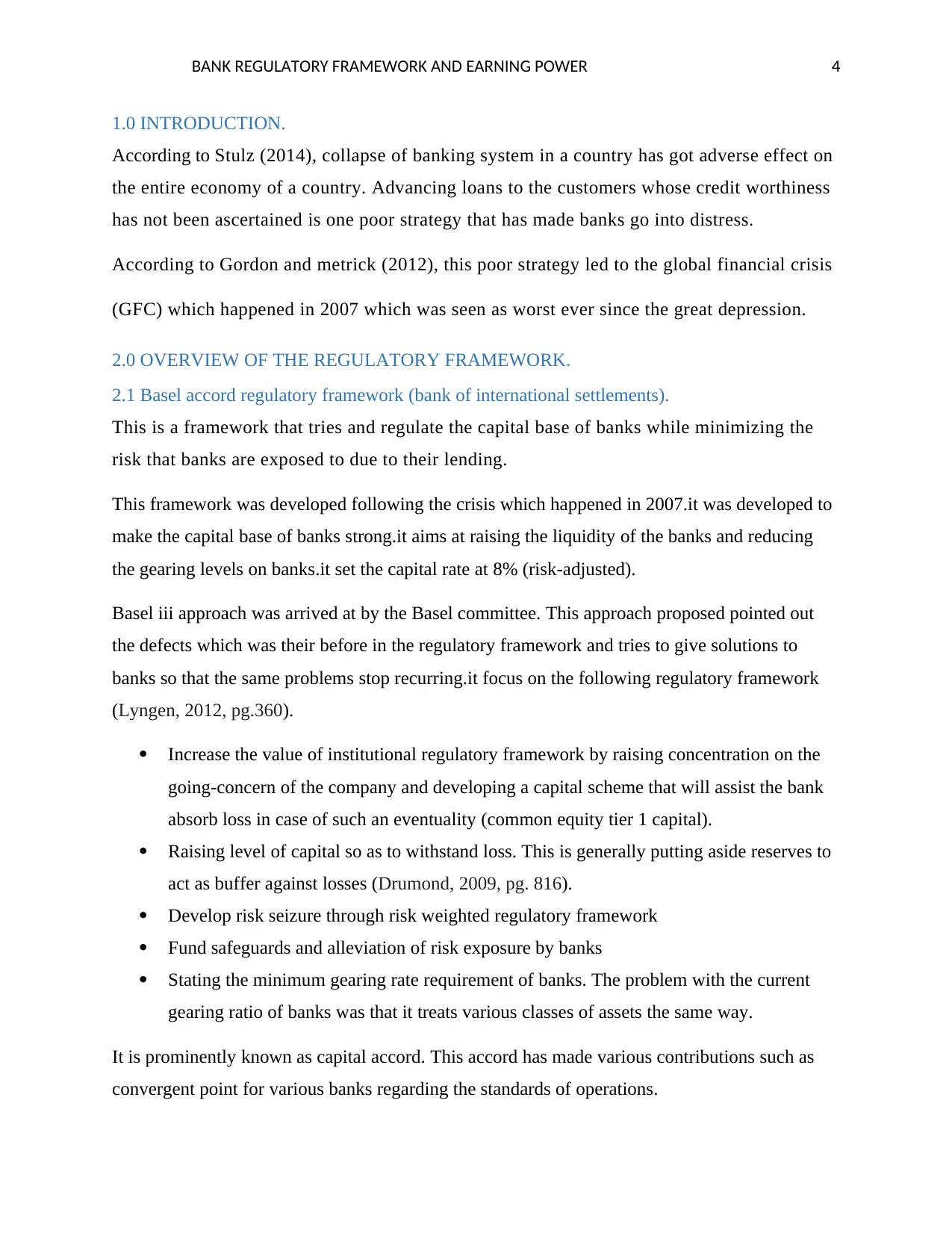
BANK REGULATORY FRAMEWORK AND EARNING POWER 4
1.0 INTRODUCTION.
According to Stulz (2014), collapse of banking system in a country has got adverse effect on
the entire economy of a country. Advancing loans to the customers whose credit worthiness
has not been ascertained is one poor strategy that has made banks go into distress.
According to Gordon and metrick (2012), this poor strategy led to the global financial crisis
(GFC) which happened in 2007 which was seen as worst ever since the great depression.
2.0 OVERVIEW OF THE REGULATORY FRAMEWORK.
2.1 Basel accord regulatory framework (bank of international settlements).
This is a framework that tries and regulate the capital base of banks while minimizing the
risk that banks are exposed to due to their lending.
This framework was developed following the crisis which happened in 2007.it was developed to
make the capital base of banks strong.it aims at raising the liquidity of the banks and reducing
the gearing levels on banks.it set the capital rate at 8% (risk-adjusted).
Basel iii approach was arrived at by the Basel committee. This approach proposed pointed out
the defects which was their before in the regulatory framework and tries to give solutions to
banks so that the same problems stop recurring.it focus on the following regulatory framework
(Lyngen, 2012, pg.360).
Increase the value of institutional regulatory framework by raising concentration on the
going-concern of the company and developing a capital scheme that will assist the bank
absorb loss in case of such an eventuality (common equity tier 1 capital).
Raising level of capital so as to withstand loss. This is generally putting aside reserves to
act as buffer against losses (Drumond, 2009, pg. 816).
Develop risk seizure through risk weighted regulatory framework
Fund safeguards and alleviation of risk exposure by banks
Stating the minimum gearing rate requirement of banks. The problem with the current
gearing ratio of banks was that it treats various classes of assets the same way.
It is prominently known as capital accord. This accord has made various contributions such as
convergent point for various banks regarding the standards of operations.
1.0 INTRODUCTION.
According to Stulz (2014), collapse of banking system in a country has got adverse effect on
the entire economy of a country. Advancing loans to the customers whose credit worthiness
has not been ascertained is one poor strategy that has made banks go into distress.
According to Gordon and metrick (2012), this poor strategy led to the global financial crisis
(GFC) which happened in 2007 which was seen as worst ever since the great depression.
2.0 OVERVIEW OF THE REGULATORY FRAMEWORK.
2.1 Basel accord regulatory framework (bank of international settlements).
This is a framework that tries and regulate the capital base of banks while minimizing the
risk that banks are exposed to due to their lending.
This framework was developed following the crisis which happened in 2007.it was developed to
make the capital base of banks strong.it aims at raising the liquidity of the banks and reducing
the gearing levels on banks.it set the capital rate at 8% (risk-adjusted).
Basel iii approach was arrived at by the Basel committee. This approach proposed pointed out
the defects which was their before in the regulatory framework and tries to give solutions to
banks so that the same problems stop recurring.it focus on the following regulatory framework
(Lyngen, 2012, pg.360).
Increase the value of institutional regulatory framework by raising concentration on the
going-concern of the company and developing a capital scheme that will assist the bank
absorb loss in case of such an eventuality (common equity tier 1 capital).
Raising level of capital so as to withstand loss. This is generally putting aside reserves to
act as buffer against losses (Drumond, 2009, pg. 816).
Develop risk seizure through risk weighted regulatory framework
Fund safeguards and alleviation of risk exposure by banks
Stating the minimum gearing rate requirement of banks. The problem with the current
gearing ratio of banks was that it treats various classes of assets the same way.
It is prominently known as capital accord. This accord has made various contributions such as
convergent point for various banks regarding the standards of operations.
Secure Best Marks with AI Grader
Need help grading? Try our AI Grader for instant feedback on your assignments.
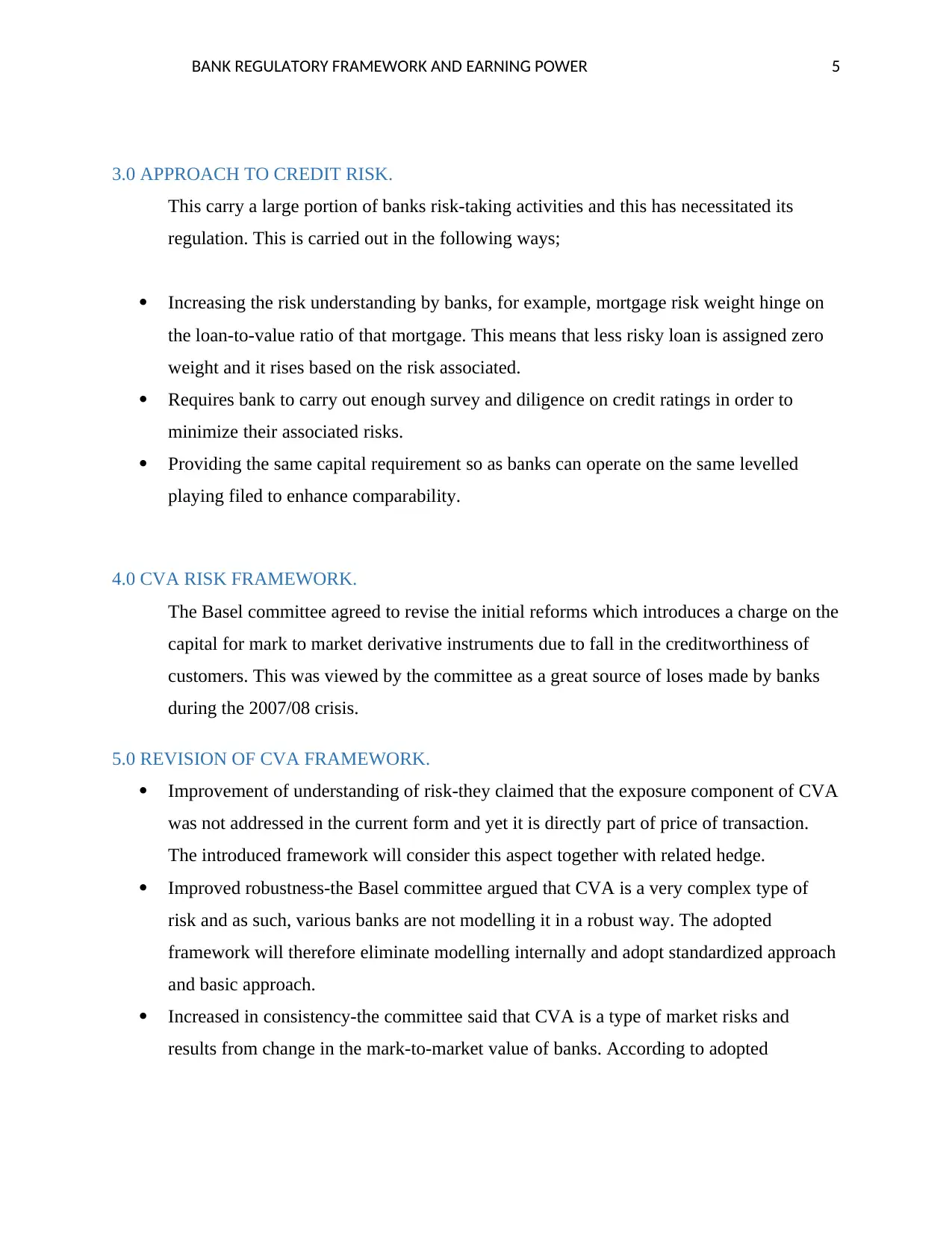
BANK REGULATORY FRAMEWORK AND EARNING POWER 5
3.0 APPROACH TO CREDIT RISK.
This carry a large portion of banks risk-taking activities and this has necessitated its
regulation. This is carried out in the following ways;
Increasing the risk understanding by banks, for example, mortgage risk weight hinge on
the loan-to-value ratio of that mortgage. This means that less risky loan is assigned zero
weight and it rises based on the risk associated.
Requires bank to carry out enough survey and diligence on credit ratings in order to
minimize their associated risks.
Providing the same capital requirement so as banks can operate on the same levelled
playing filed to enhance comparability.
4.0 CVA RISK FRAMEWORK.
The Basel committee agreed to revise the initial reforms which introduces a charge on the
capital for mark to market derivative instruments due to fall in the creditworthiness of
customers. This was viewed by the committee as a great source of loses made by banks
during the 2007/08 crisis.
5.0 REVISION OF CVA FRAMEWORK.
Improvement of understanding of risk-they claimed that the exposure component of CVA
was not addressed in the current form and yet it is directly part of price of transaction.
The introduced framework will consider this aspect together with related hedge.
Improved robustness-the Basel committee argued that CVA is a very complex type of
risk and as such, various banks are not modelling it in a robust way. The adopted
framework will therefore eliminate modelling internally and adopt standardized approach
and basic approach.
Increased in consistency-the committee said that CVA is a type of market risks and
results from change in the mark-to-market value of banks. According to adopted
3.0 APPROACH TO CREDIT RISK.
This carry a large portion of banks risk-taking activities and this has necessitated its
regulation. This is carried out in the following ways;
Increasing the risk understanding by banks, for example, mortgage risk weight hinge on
the loan-to-value ratio of that mortgage. This means that less risky loan is assigned zero
weight and it rises based on the risk associated.
Requires bank to carry out enough survey and diligence on credit ratings in order to
minimize their associated risks.
Providing the same capital requirement so as banks can operate on the same levelled
playing filed to enhance comparability.
4.0 CVA RISK FRAMEWORK.
The Basel committee agreed to revise the initial reforms which introduces a charge on the
capital for mark to market derivative instruments due to fall in the creditworthiness of
customers. This was viewed by the committee as a great source of loses made by banks
during the 2007/08 crisis.
5.0 REVISION OF CVA FRAMEWORK.
Improvement of understanding of risk-they claimed that the exposure component of CVA
was not addressed in the current form and yet it is directly part of price of transaction.
The introduced framework will consider this aspect together with related hedge.
Improved robustness-the Basel committee argued that CVA is a very complex type of
risk and as such, various banks are not modelling it in a robust way. The adopted
framework will therefore eliminate modelling internally and adopt standardized approach
and basic approach.
Increased in consistency-the committee said that CVA is a type of market risks and
results from change in the mark-to-market value of banks. According to adopted
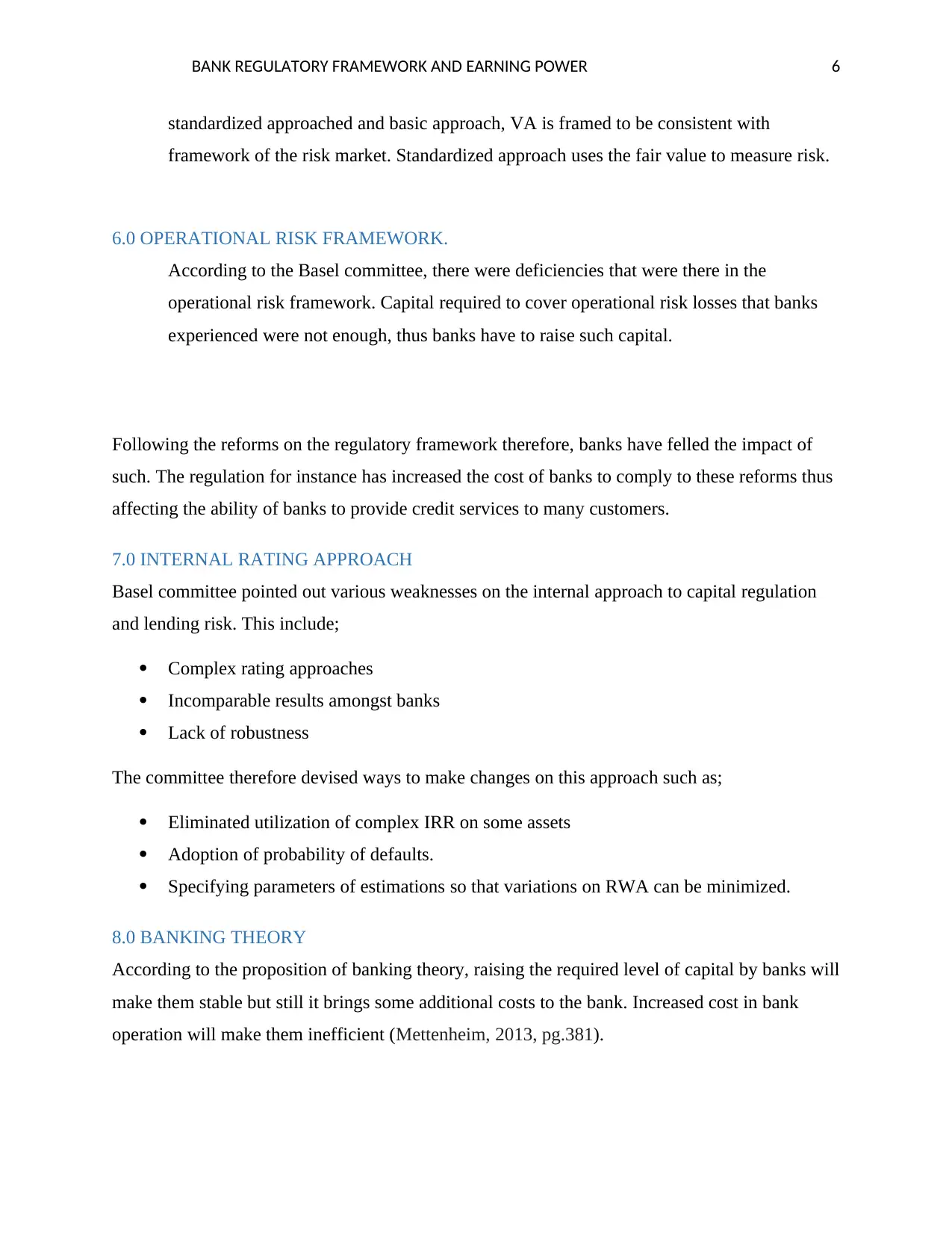
BANK REGULATORY FRAMEWORK AND EARNING POWER 6
standardized approached and basic approach, VA is framed to be consistent with
framework of the risk market. Standardized approach uses the fair value to measure risk.
6.0 OPERATIONAL RISK FRAMEWORK.
According to the Basel committee, there were deficiencies that were there in the
operational risk framework. Capital required to cover operational risk losses that banks
experienced were not enough, thus banks have to raise such capital.
Following the reforms on the regulatory framework therefore, banks have felled the impact of
such. The regulation for instance has increased the cost of banks to comply to these reforms thus
affecting the ability of banks to provide credit services to many customers.
7.0 INTERNAL RATING APPROACH
Basel committee pointed out various weaknesses on the internal approach to capital regulation
and lending risk. This include;
Complex rating approaches
Incomparable results amongst banks
Lack of robustness
The committee therefore devised ways to make changes on this approach such as;
Eliminated utilization of complex IRR on some assets
Adoption of probability of defaults.
Specifying parameters of estimations so that variations on RWA can be minimized.
8.0 BANKING THEORY
According to the proposition of banking theory, raising the required level of capital by banks will
make them stable but still it brings some additional costs to the bank. Increased cost in bank
operation will make them inefficient (Mettenheim, 2013, pg.381).
standardized approached and basic approach, VA is framed to be consistent with
framework of the risk market. Standardized approach uses the fair value to measure risk.
6.0 OPERATIONAL RISK FRAMEWORK.
According to the Basel committee, there were deficiencies that were there in the
operational risk framework. Capital required to cover operational risk losses that banks
experienced were not enough, thus banks have to raise such capital.
Following the reforms on the regulatory framework therefore, banks have felled the impact of
such. The regulation for instance has increased the cost of banks to comply to these reforms thus
affecting the ability of banks to provide credit services to many customers.
7.0 INTERNAL RATING APPROACH
Basel committee pointed out various weaknesses on the internal approach to capital regulation
and lending risk. This include;
Complex rating approaches
Incomparable results amongst banks
Lack of robustness
The committee therefore devised ways to make changes on this approach such as;
Eliminated utilization of complex IRR on some assets
Adoption of probability of defaults.
Specifying parameters of estimations so that variations on RWA can be minimized.
8.0 BANKING THEORY
According to the proposition of banking theory, raising the required level of capital by banks will
make them stable but still it brings some additional costs to the bank. Increased cost in bank
operation will make them inefficient (Mettenheim, 2013, pg.381).

BANK REGULATORY FRAMEWORK AND EARNING POWER 7
In the ideas of Benediktsdottir, Danielsson, Zoega (2011), banks used to collapse because of
weak regulations on their minimum required capital, liquidity and gearing rate. When banks have
strong capital base, they tend to offset any loss that may results. Excess capital will act as a
buffer against loss.
9.0 FEATURES AND CONSEQUENCES OF REGULATIORY FRAMEWORK ON
LENDING AND EARNING POWER OF BANKS.
According to Volcker rule (2012), banks are not allowed to participate in short-term exclusive
trading of stocks from their account. This affected the banks’ lending power thus confining
banks to only lending to a few individuals (Duffie, 2012, 106).
According to the requirements of Dodd frank act, banks are supposed to have enough capital
base so as to make them highly liquid so that they can be able to offset losses in case of
economic shocks.it also requires banks to reduce their gearing ratio and increase their risk
management systems. reduced debt will reduce the profitability of banks while the risks
management systems will have increased the cost of compliance. This has hindered the
profitability of banks (Dimitrov, Palia & Tang, 2015, pg.510).
The regulatory framework also proposed that large banks must hold minimum amount of liquid
asset base than can be used to mitigate losses in case of an eventuality.
Increased in capital requirements, capital buffers and the minimum liquidity will adversely
impact on the profitability of banks. There will be an increased cost to retain high capital
requirements which will in turn affect the pricing of credit portfolio (Allen, Chan, Milne
&Thomas, 2012, pg. 165).
Banks will therefore sort for various ways to minimize lending while struggling to comply with
regulations.
Banks will reduce lending amounts because they will try to reduce high-risk weighted
assets and lower the premiums of high quality assets. This is because when value of this
assets reduces the risk will rise.
High capital requirements as per the regulation will adversely impact on lending to
sectors that are deemed to be highly risky like real estate and corporate lending. This will
reduce the incomes of banks (Repullo &Suarez, 2012, pg. 460).
In the ideas of Benediktsdottir, Danielsson, Zoega (2011), banks used to collapse because of
weak regulations on their minimum required capital, liquidity and gearing rate. When banks have
strong capital base, they tend to offset any loss that may results. Excess capital will act as a
buffer against loss.
9.0 FEATURES AND CONSEQUENCES OF REGULATIORY FRAMEWORK ON
LENDING AND EARNING POWER OF BANKS.
According to Volcker rule (2012), banks are not allowed to participate in short-term exclusive
trading of stocks from their account. This affected the banks’ lending power thus confining
banks to only lending to a few individuals (Duffie, 2012, 106).
According to the requirements of Dodd frank act, banks are supposed to have enough capital
base so as to make them highly liquid so that they can be able to offset losses in case of
economic shocks.it also requires banks to reduce their gearing ratio and increase their risk
management systems. reduced debt will reduce the profitability of banks while the risks
management systems will have increased the cost of compliance. This has hindered the
profitability of banks (Dimitrov, Palia & Tang, 2015, pg.510).
The regulatory framework also proposed that large banks must hold minimum amount of liquid
asset base than can be used to mitigate losses in case of an eventuality.
Increased in capital requirements, capital buffers and the minimum liquidity will adversely
impact on the profitability of banks. There will be an increased cost to retain high capital
requirements which will in turn affect the pricing of credit portfolio (Allen, Chan, Milne
&Thomas, 2012, pg. 165).
Banks will therefore sort for various ways to minimize lending while struggling to comply with
regulations.
Banks will reduce lending amounts because they will try to reduce high-risk weighted
assets and lower the premiums of high quality assets. This is because when value of this
assets reduces the risk will rise.
High capital requirements as per the regulation will adversely impact on lending to
sectors that are deemed to be highly risky like real estate and corporate lending. This will
reduce the incomes of banks (Repullo &Suarez, 2012, pg. 460).
Paraphrase This Document
Need a fresh take? Get an instant paraphrase of this document with our AI Paraphraser
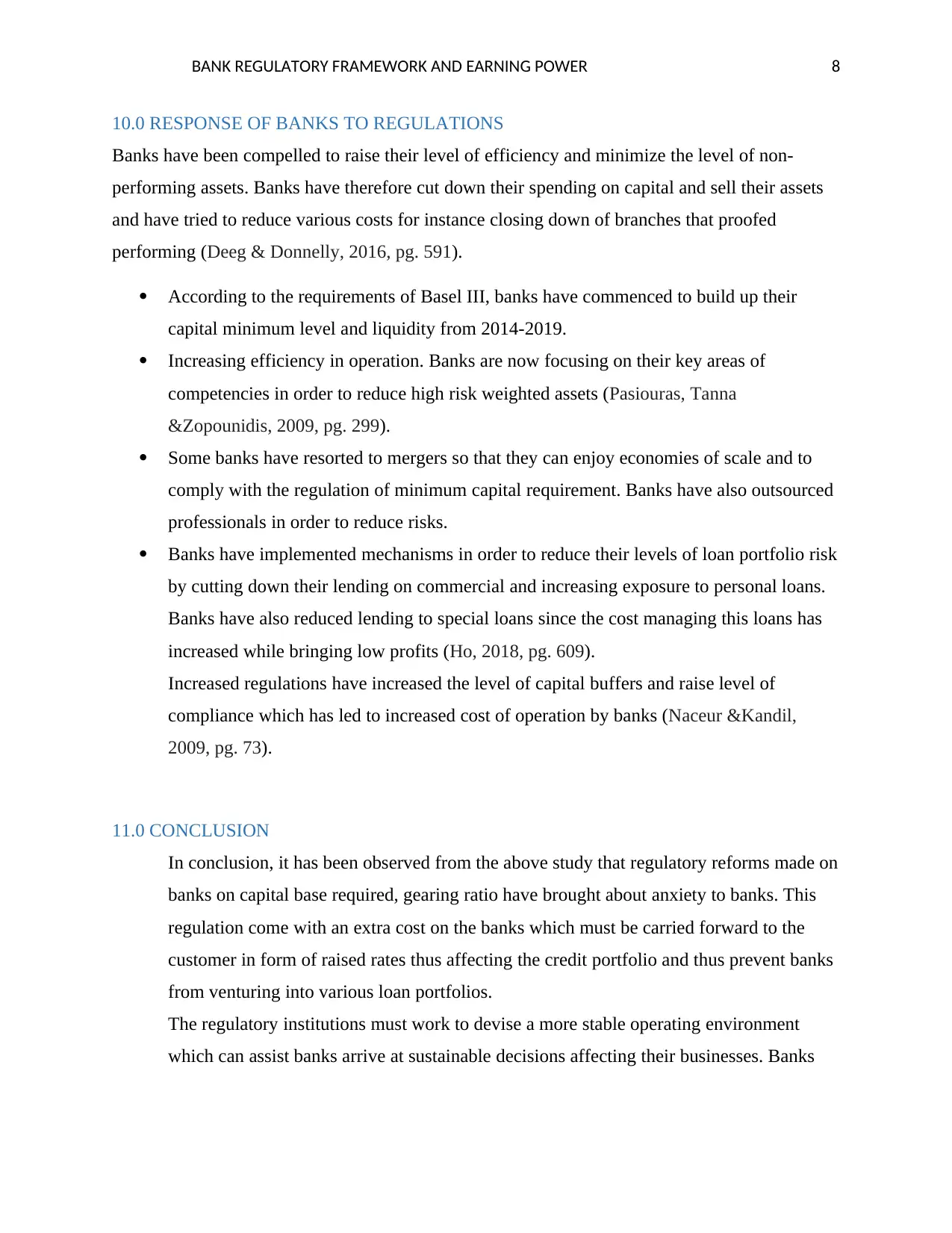
BANK REGULATORY FRAMEWORK AND EARNING POWER 8
10.0 RESPONSE OF BANKS TO REGULATIONS
Banks have been compelled to raise their level of efficiency and minimize the level of non-
performing assets. Banks have therefore cut down their spending on capital and sell their assets
and have tried to reduce various costs for instance closing down of branches that proofed
performing (Deeg & Donnelly, 2016, pg. 591).
According to the requirements of Basel III, banks have commenced to build up their
capital minimum level and liquidity from 2014-2019.
Increasing efficiency in operation. Banks are now focusing on their key areas of
competencies in order to reduce high risk weighted assets (Pasiouras, Tanna
&Zopounidis, 2009, pg. 299).
Some banks have resorted to mergers so that they can enjoy economies of scale and to
comply with the regulation of minimum capital requirement. Banks have also outsourced
professionals in order to reduce risks.
Banks have implemented mechanisms in order to reduce their levels of loan portfolio risk
by cutting down their lending on commercial and increasing exposure to personal loans.
Banks have also reduced lending to special loans since the cost managing this loans has
increased while bringing low profits (Ho, 2018, pg. 609).
Increased regulations have increased the level of capital buffers and raise level of
compliance which has led to increased cost of operation by banks (Naceur &Kandil,
2009, pg. 73).
11.0 CONCLUSION
In conclusion, it has been observed from the above study that regulatory reforms made on
banks on capital base required, gearing ratio have brought about anxiety to banks. This
regulation come with an extra cost on the banks which must be carried forward to the
customer in form of raised rates thus affecting the credit portfolio and thus prevent banks
from venturing into various loan portfolios.
The regulatory institutions must work to devise a more stable operating environment
which can assist banks arrive at sustainable decisions affecting their businesses. Banks
10.0 RESPONSE OF BANKS TO REGULATIONS
Banks have been compelled to raise their level of efficiency and minimize the level of non-
performing assets. Banks have therefore cut down their spending on capital and sell their assets
and have tried to reduce various costs for instance closing down of branches that proofed
performing (Deeg & Donnelly, 2016, pg. 591).
According to the requirements of Basel III, banks have commenced to build up their
capital minimum level and liquidity from 2014-2019.
Increasing efficiency in operation. Banks are now focusing on their key areas of
competencies in order to reduce high risk weighted assets (Pasiouras, Tanna
&Zopounidis, 2009, pg. 299).
Some banks have resorted to mergers so that they can enjoy economies of scale and to
comply with the regulation of minimum capital requirement. Banks have also outsourced
professionals in order to reduce risks.
Banks have implemented mechanisms in order to reduce their levels of loan portfolio risk
by cutting down their lending on commercial and increasing exposure to personal loans.
Banks have also reduced lending to special loans since the cost managing this loans has
increased while bringing low profits (Ho, 2018, pg. 609).
Increased regulations have increased the level of capital buffers and raise level of
compliance which has led to increased cost of operation by banks (Naceur &Kandil,
2009, pg. 73).
11.0 CONCLUSION
In conclusion, it has been observed from the above study that regulatory reforms made on
banks on capital base required, gearing ratio have brought about anxiety to banks. This
regulation come with an extra cost on the banks which must be carried forward to the
customer in form of raised rates thus affecting the credit portfolio and thus prevent banks
from venturing into various loan portfolios.
The regulatory institutions must work to devise a more stable operating environment
which can assist banks arrive at sustainable decisions affecting their businesses. Banks

BANK REGULATORY FRAMEWORK AND EARNING POWER 9
should therefore have sought advices from those bodies on various ways of mitigating
risks and how to identify risky ventures.
Regulatory framework should have sought to bring to equilibrium the requirement of
sustainable economic growth and levelled playing ground for banks to provide credit to
various sectors of the economy.in practice, most countries that regulate their banking
services heavily tend to remain behind in terms of economic growth.
should therefore have sought advices from those bodies on various ways of mitigating
risks and how to identify risky ventures.
Regulatory framework should have sought to bring to equilibrium the requirement of
sustainable economic growth and levelled playing ground for banks to provide credit to
various sectors of the economy.in practice, most countries that regulate their banking
services heavily tend to remain behind in terms of economic growth.
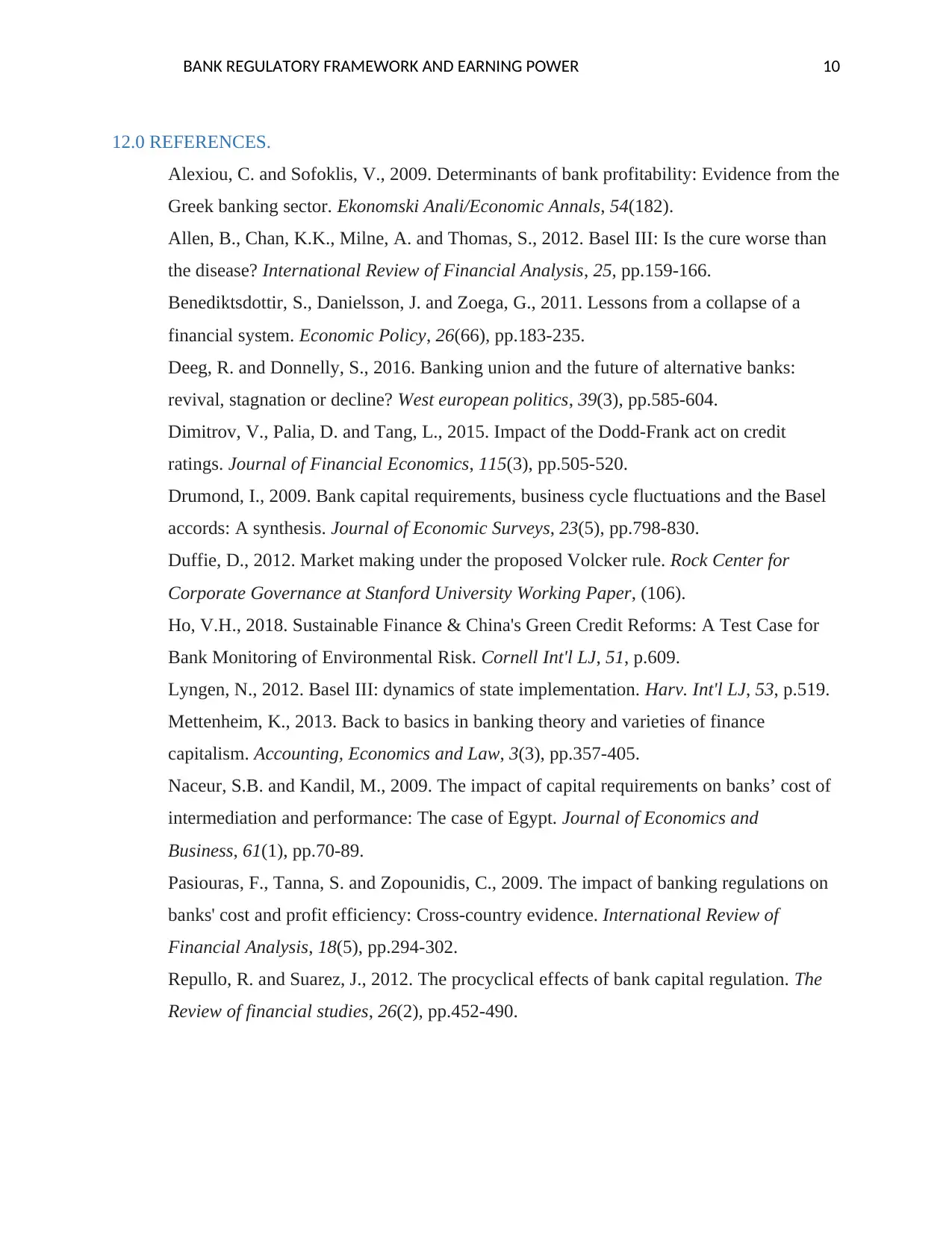
BANK REGULATORY FRAMEWORK AND EARNING POWER 10
12.0 REFERENCES.
Alexiou, C. and Sofoklis, V., 2009. Determinants of bank profitability: Evidence from the
Greek banking sector. Ekonomski Anali/Economic Annals, 54(182).
Allen, B., Chan, K.K., Milne, A. and Thomas, S., 2012. Basel III: Is the cure worse than
the disease? International Review of Financial Analysis, 25, pp.159-166.
Benediktsdottir, S., Danielsson, J. and Zoega, G., 2011. Lessons from a collapse of a
financial system. Economic Policy, 26(66), pp.183-235.
Deeg, R. and Donnelly, S., 2016. Banking union and the future of alternative banks:
revival, stagnation or decline? West european politics, 39(3), pp.585-604.
Dimitrov, V., Palia, D. and Tang, L., 2015. Impact of the Dodd-Frank act on credit
ratings. Journal of Financial Economics, 115(3), pp.505-520.
Drumond, I., 2009. Bank capital requirements, business cycle fluctuations and the Basel
accords: A synthesis. Journal of Economic Surveys, 23(5), pp.798-830.
Duffie, D., 2012. Market making under the proposed Volcker rule. Rock Center for
Corporate Governance at Stanford University Working Paper, (106).
Ho, V.H., 2018. Sustainable Finance & China's Green Credit Reforms: A Test Case for
Bank Monitoring of Environmental Risk. Cornell Int'l LJ, 51, p.609.
Lyngen, N., 2012. Basel III: dynamics of state implementation. Harv. Int'l LJ, 53, p.519.
Mettenheim, K., 2013. Back to basics in banking theory and varieties of finance
capitalism. Accounting, Economics and Law, 3(3), pp.357-405.
Naceur, S.B. and Kandil, M., 2009. The impact of capital requirements on banks’ cost of
intermediation and performance: The case of Egypt. Journal of Economics and
Business, 61(1), pp.70-89.
Pasiouras, F., Tanna, S. and Zopounidis, C., 2009. The impact of banking regulations on
banks' cost and profit efficiency: Cross-country evidence. International Review of
Financial Analysis, 18(5), pp.294-302.
Repullo, R. and Suarez, J., 2012. The procyclical effects of bank capital regulation. The
Review of financial studies, 26(2), pp.452-490.
12.0 REFERENCES.
Alexiou, C. and Sofoklis, V., 2009. Determinants of bank profitability: Evidence from the
Greek banking sector. Ekonomski Anali/Economic Annals, 54(182).
Allen, B., Chan, K.K., Milne, A. and Thomas, S., 2012. Basel III: Is the cure worse than
the disease? International Review of Financial Analysis, 25, pp.159-166.
Benediktsdottir, S., Danielsson, J. and Zoega, G., 2011. Lessons from a collapse of a
financial system. Economic Policy, 26(66), pp.183-235.
Deeg, R. and Donnelly, S., 2016. Banking union and the future of alternative banks:
revival, stagnation or decline? West european politics, 39(3), pp.585-604.
Dimitrov, V., Palia, D. and Tang, L., 2015. Impact of the Dodd-Frank act on credit
ratings. Journal of Financial Economics, 115(3), pp.505-520.
Drumond, I., 2009. Bank capital requirements, business cycle fluctuations and the Basel
accords: A synthesis. Journal of Economic Surveys, 23(5), pp.798-830.
Duffie, D., 2012. Market making under the proposed Volcker rule. Rock Center for
Corporate Governance at Stanford University Working Paper, (106).
Ho, V.H., 2018. Sustainable Finance & China's Green Credit Reforms: A Test Case for
Bank Monitoring of Environmental Risk. Cornell Int'l LJ, 51, p.609.
Lyngen, N., 2012. Basel III: dynamics of state implementation. Harv. Int'l LJ, 53, p.519.
Mettenheim, K., 2013. Back to basics in banking theory and varieties of finance
capitalism. Accounting, Economics and Law, 3(3), pp.357-405.
Naceur, S.B. and Kandil, M., 2009. The impact of capital requirements on banks’ cost of
intermediation and performance: The case of Egypt. Journal of Economics and
Business, 61(1), pp.70-89.
Pasiouras, F., Tanna, S. and Zopounidis, C., 2009. The impact of banking regulations on
banks' cost and profit efficiency: Cross-country evidence. International Review of
Financial Analysis, 18(5), pp.294-302.
Repullo, R. and Suarez, J., 2012. The procyclical effects of bank capital regulation. The
Review of financial studies, 26(2), pp.452-490.
1 out of 10
![[object Object]](/_next/static/media/star-bottom.7253800d.svg)





